Ever wondered if that flavorful, spice-crusted dish packs more than just taste? Cajun-style cooking brings bold flavors, but does it also deliver nutritional benefits? Let’s dive into the facts behind this popular method.
Originating in New Orleans, blackened fish gained fame thanks to Chef Paul Prudhomme. The technique involves coating fillets with a mix of paprika, chili powder, thyme, and garlic before searing. This creates a rich, smoky crust while keeping the inside tender.
With 34g of protein and 232 calories per serving, it’s a protein powerhouse. The American Heart Association recommends fish twice weekly for heart health. Plus, many recipes fit gluten-free and diabetic-friendly diets.
Key Takeaways
- Cajun-style cooking uses spices like paprika and garlic for bold flavor.
- Each serving offers 34g protein, supporting muscle health.
- Contains 232 calories, making it a lean yet satisfying option.
- Diabetic-friendly and gluten-free variations exist for dietary needs.
- Learn more about similar nutrient-rich fish options.
Introduction to Blackened Fish
Louisiana kitchens perfected a fiery cooking method that revolutionized seafood. Originating in Cajun cuisine, this technique gained fame at K-Paul’s Louisiana Kitchen in the 1980s. Chef Paul Prudhomme’s blend of paprika, thyme, and chili powder became legendary.
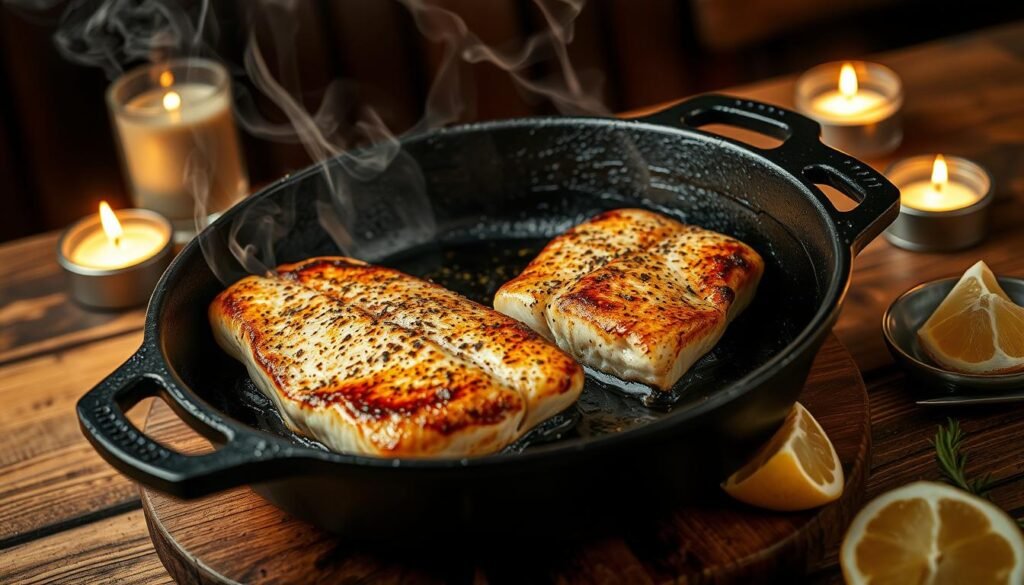
Traditionally, fillets were dipped in butter before searing. Today, many opt for olive oil—a lighter alternative that still delivers a crispy crust. The high heat chars the spices, not the protein, creating a smoky aroma.
Texture and taste set it apart. Unlike grilled dishes, the blackening technique adds a crackling exterior while keeping the inside moist. Restaurants nationwide feature it, from tuna steaks to cauliflower.
- Versatile: Works with chicken, shrimp, or even plant-based proteins.
- Misunderstood: The dark crust comes from spice caramelization, not burning.
- Adaptable Modern recipes simplify seasoning without losing bold flavor.
For a deeper dive into the blackening technique, explore its evolution from New Orleans to home kitchens.
Is Blackened Fish Healthy? The Nutritional Breakdown
That crispy, spice-coated dish might surprise you with its nutritional perks. A 4oz serving packs 238 calories and 10g of fat, balancing flavor with lean energy. Let’s dissect what makes this Cajun staple a smart choice.
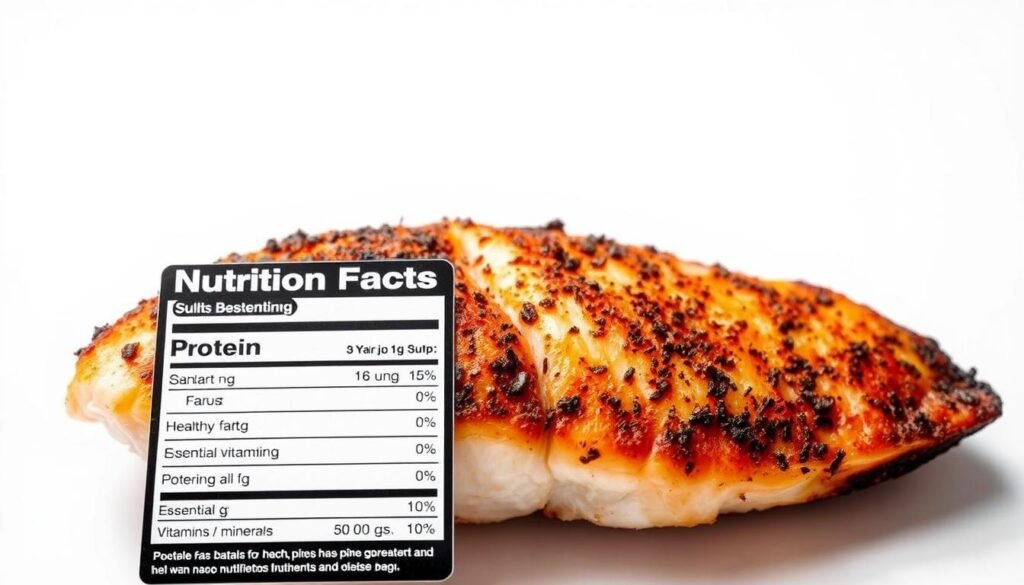
Calories and Macronutrients
34g of protein per serving supports muscle repair and keeps you full longer. With just 2g carbs, it’s ideal for low-carb diets. Olive oil adds heart-smart monounsaturated fats, boosting omega-3s.
Vitamins and Minerals
One portion delivers 100% of your daily vitamin B12—key for nerve health. Spices like paprika contribute iron and potassium. Chili powder offers vitamin A, while garlic adds immune-boosting compounds.
Comparing Cooking Methods
Blackening uses 40% fewer calories than deep-frying. Unlike baking, it locks in moisture without extra butter. Watch sodium levels in pre-mixed seasonings; opt for homemade blends to control salt.
- Better than fried: Less oil, more crunch.
- Spice power: Antioxidants from herbs outperform plain grilling.
- Versatile: Works with salmon, cod, or even tofu.
Health Benefits of Blackened Fish
Beyond its bold flavor, this Cajun-inspired dish delivers impressive wellness perks. Packed with muscle-fueling protein and smart fats, it’s a nutritional multitasker. Let’s explore how it supports your body from the inside out.
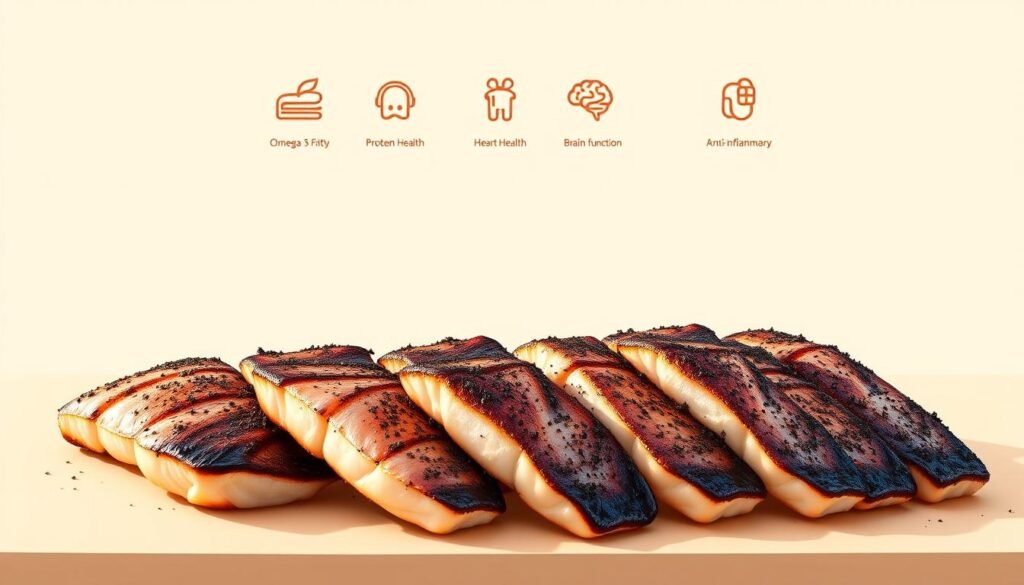
High Protein Content for Muscle Health
34 grams of protein per serving makes this dish a recovery champion. Protein repairs tissues and keeps hunger at bay for hours. Athletes and busy pros alike benefit from its satiating power.
Compared to fried alternatives, it offers 40% more protein per calorie. Studies show lean protein sources like this help maintain metabolism. Tip: Pair with quinoa for a complete amino acid profile.
Heart-Healthy Fats from Olive Oil
Modern recipes swap butter for olive oil, rich in monounsaturated fats. These fats improve cholesterol levels, reducing heart disease risk. The Mediterranean diet praises such oils for longevity.
“Regular intake of omega-3s from fish and olive oil lowers inflammation,” notes a Seafood Nutrition study. Spices like paprika also boost antioxidant absorption.
Low-Calorie Option for Weight Management
At 232 calories per serving, it’s a low-calorie star. The spice blend’s thermogenic effect may slightly increase calorie burn. Portion control is effortless—no heavy sauces needed.
For comparison:
- Fried cod: 290 calories
- Grilled salmon: 280 calories
- Blackened tilapia: 232 calories
Diabetic-friendly and gluten-free versions make it adaptable for diverse diets.
Key Ingredients in Blackened Fish and Their Benefits
The magic behind this flavorful dish lies in its carefully chosen components. Each element contributes distinct nutritional advantages while building layers of taste. Let’s explore what makes these ingredients stand out.
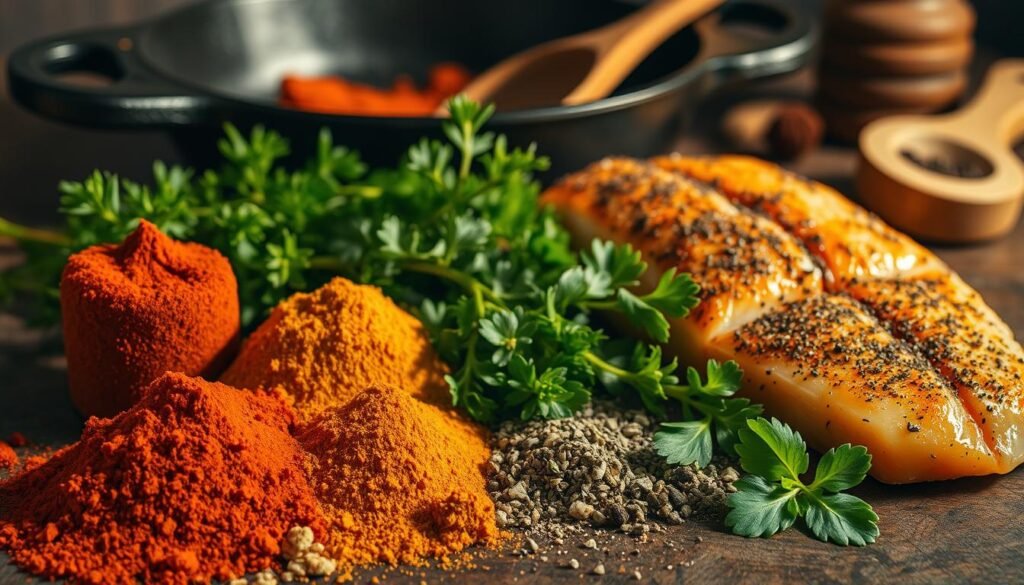
Olive Oil: A Healthy Fat Source
Two tablespoons per recipe provide heart-smart monounsaturated fats. With a smoke point of 410°F, it withstands high-heat cooking better than butter. Studies link regular consumption to improved cholesterol levels.
Comparison of cooking oils:
- Olive oil: 410°F smoke point, rich in antioxidants
- Butter: 302°F smoke point, higher saturated fat
- Avocado oil: 520°F smoke point, neutral flavor
Paprika and Chili Powder: Antioxidant-Rich Spices
One teaspoon of paprika delivers 15% of your daily vitamin A needs. Chili powder contains capsaicinoids that may boost metabolism. Together, they provide:
- Anti-inflammatory properties
- Enhanced iron absorption
- Natural flavor without excess sodium
Fresh Fish: Lean Protein Powerhouse
Wild-caught salmon offers 22g protein per 3oz serving with minimal saturated fat. When selecting fillets:
- Look for firm, translucent flesh
- Choose sustainable options like Alaskan cod
- Fresh catches have brighter gills than frozen
Basa vs. salmon nutrition per 100g:
| Calories | Protein | Omega-3s | |
|---|---|---|---|
| Salmon | 208 | 20g | 2.3g |
| Basa | 90 | 13g | 0.5g |
How to Make Healthy Blackened Fish at Home
Bring restaurant-quality flavor to your kitchen with this simple yet flavorful method. A few smart choices—like selecting fresh fillets and controlling heat—ensure a crispy crust without excess calories. Follow these steps for a foolproof blackened fish recipe every time.
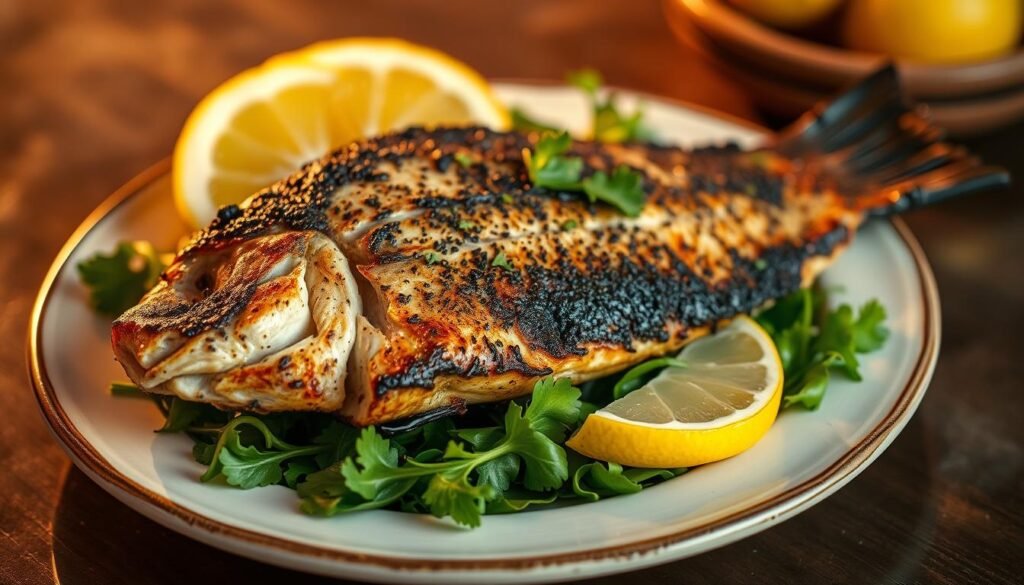
Choosing the Right Fish for Blackening
Opt for firm, thick cuts like salmon, cod, or mahi-mahi. Thin fillets overcook easily, while thicker ones (1–1.5 inches) sear evenly. Always pat dry with paper towels to prevent steaming.
- Sustainable picks: Wild-caught Alaskan cod or U.S.-farmed tilapia.
- Avoid: Delicate fish like sole, which falls apart under heat.
Preparing the Perfect Blackened Seasoning
Skip store-bought mixes loaded with salt. A homemade blackened seasoning blend takes 5 minutes:
| Ingredient | Amount | Benefit |
|---|---|---|
| Paprika | 2 tbsp | Adds color & vitamin A |
| Garlic powder | 1 tbsp | Boosts immunity |
| Cayenne | 1 tsp | Enhances metabolism |
Cooking Techniques for Optimal Health
Use a cast-iron or nonstick pan on medium-high heat. Cook 2–3 minutes per side—no flipping more than once. For less oil, brush fillets instead of dunking them.
- Tool tip: A fish spatula prevents flaking.
- Broiling alternative: 3–4 minutes under high heat for a charred finish.
Blackened Fish Recipe: A Step-by-Step Guide
Transform simple fillets into a flavor-packed meal with this foolproof method. Whether you’re a beginner or a seasoned cook, these steps ensure crispy, spicy perfection every time.
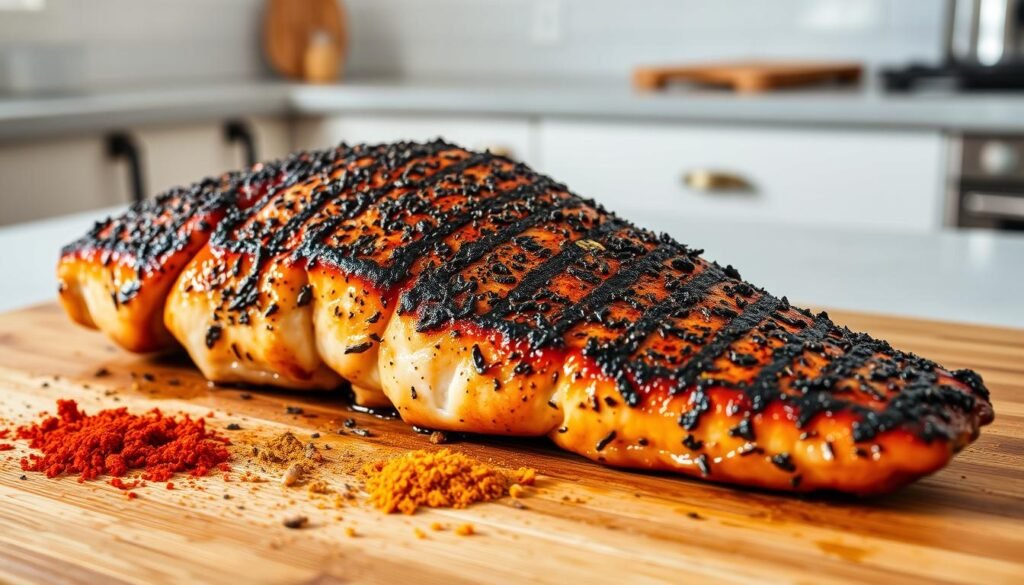
Ingredients You’ll Need
Gather these essentials for a balanced blend of heat and depth:
- 1 lb firm white fish (cod, mahi-mahi, or tilapia)
- 2 tablespoons olive oil (or avocado oil for higher smoke point)
Homemade Spice Mix:
| Ingredient | Amount | Note |
|---|---|---|
| Paprika | 2 tbsp | Smoky or sweet variety |
| Garlic powder | 1 tbsp | Boosts umami |
| Chili powder | 1 tsp | Adjust for heat preference |
Step-by-Step Cooking Instructions
- Prep the fish: Pat fillets dry with paper towels. Moisture prevents proper searing.
- Season generously: Coat both sides with spice mix. Press gently to adhere.
- Heat the pan: Use cast iron on medium-high until oil shimmers (about 2 minutes).
- Sear: Cook 3–4 minutes per side until crust forms. Flip only once.
“The key to blackening? Let the spices caramelize—don’t rush the sear.”
Tips for Perfect Blackened Fish Every Time
- Check doneness: Flesh flakes easily at 145°F. No thermometer? Look for opaque edges.
- Multi-method options: Bake at 450°F for 10 minutes or grill on high for 4 minutes side.
- Spice swaps: Replace chili powder with cayenne for extra kick or smoked salt for depth.
Storage: Refrigerate leftovers up to 2 days. Reheat in a dry skillet to revive crispness.
Serving Suggestions for Blackened Fish
Elevate your meal with perfect pairings that enhance every bite. The right sides and sauces can balance bold flavors while adding nutritional value. Here’s how to create a well-rounded plate.

Healthy Side Dishes to Pair
Oven-baked sweet potato fries add a touch of sweetness. Their natural sugars caramelize, contrasting the spicy crust. For grains, try quinoa or wild rice—fiber-rich bases that soak up flavors.
Seasonal vegetables like roasted asparagus or zucchini keep things light. Pro tip: Toss veggies in olive oil and garlic powder for extra depth. Kids love corn on the cob—a fun, mess-free option.
Salads That Complement the Dish
Crisp greens balance the heat. A mango-avocado salad with lime dressing brings tropical flair. For crunch, add jicama or cucumber slices.
- Citrus vinaigrettes: Orange or grapefruit cuts through richness.
- Herb-heavy mixes: Cilantro or mint brighten each forkful.
Light and Flavorful Sauces
Drizzle dairy-free herb butter made with olive oil and parsley. Mango salsa (diced mango, red onion, jalapeño) adds juicy sweetness. For creaminess without guilt, blend Greek yogurt with dill.
“A sauce should whisper, not shout—let the fish remain the star.”
Wine pairings: Sauvignon Blanc or a light Pinot Noir harmonize with smoky notes. For non-alcoholic options, sparkling water with lime refreshes the palate.
Common Mistakes to Avoid When Making Blackened Fish
Mastering this Cajun classic requires avoiding a few key pitfalls. The cooking technique seems simple, but small errors can turn tender fillets into dry disappointments. Let’s explore how to sidestep the most frequent blunders.
Overcooking the Fish
High heat demands perfect timing. Fish cooked too long loses moisture, becoming flaky in the wrong way. Watch for these signs:
- Texture: Flesh separates into dry strands instead of moist flakes
- Color: Spice crust turns from dark brown to black
- Flex test: Properly done fillets spring back slightly when pressed
Use a timer—most fillets need just 3 minutes per side. Remove from heat at 145°F internal temperature.
Using Too Much Oil or Butter
While fat carries flavor, excess creates greasy results. For four fillets:
| Oil Type | Ideal Amount |
|---|---|
| Olive oil | 2 tablespoons |
| Avocado oil | 1.5 tablespoons |
Brush rather than pour to distribute evenly. Overcrowding the pan also causes oil pooling.
Skipping the Pat-Dry Step
Surface moisture prevents proper searing. Always pat dry with paper towels before seasoning. This creates the ideal surface for spice adhesion and crust formation.
Pro tip: Make sure your pan reaches medium-high heat before adding fillets. One favorite chef’s trick? Sprinkle a few water drops—they should dance, not sizzle away instantly.
Conclusion
A 20-minute meal with 34g high protein? Yes, please. This blackened fish dish delivers muscle fuel and heart-smart fats without sacrificing flavor.
Perfect for busy weeknights, it fits gluten-free and diabetic diets. The spice blend adds antioxidants, while olive oil keeps it healthy.
Ready to experiment? Try swapping cod for salmon or adding citrus zest to the recipe. Nutritionists praise its balance—crispy, bold, and nourishing.




